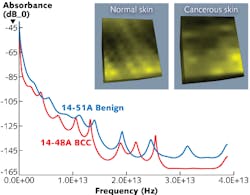Terahertz reflectometry identifies early skin cancer
Applied Research & Photonics (ARP; Harrisburg, PA) is applying its terahertz-reflectometry systems—which have also been used for multilayer paint-thickness analysis and fault detection in silicon chips—to the identification of early-stage skin cancer. In the experimental setup, both benign and basal cell carcinoma (BCC) skin samples are analyzed using terahertz reflectometry, terahertz time-domain spectroscopy, and terahertz imaging. The electro-optic dendrimer (EOD)-based continuous-wave (CW) terahertz source—which emits broadband energy from 1 THz to approximately 35 THz—exploits a mechanism invented by ARP called dendrimer dipole excitation (DDE). This mechanism stems from the fact that the EOD has a high electro-optic coefficient (around 130 pm/V) and thus offers high conversion efficiency.
The terahertz source is reflected off the highly layered structure of human skin and the layering information is obtained by subtracting the reflected intensity data from the baseline (empty cell) data. Data analysis reveals that healthy skin is evenly layered while the layering pattern of cancerous cells is significantly diminished, indicating cell agglomeration and/or tumor formation. Measurements with an ARP TeraSpectra spectrometer confirm that healthy skin produces a terahertz spectrum that is different than diseased skin. A reconstructive-imaging algorithm is used to create 3D skin images that confirm healthy skin exhibits a regular cellular pattern while the cancerous tissue is amorphous. The noninvasive technique could eliminate the need for biopsy as the main mode of skin-cancer diagnosis. Contact Anis Rahman at [email protected].
About the Author

Gail Overton
Senior Editor (2004-2020)
Gail has more than 30 years of engineering, marketing, product management, and editorial experience in the photonics and optical communications industry. Before joining the staff at Laser Focus World in 2004, she held many product management and product marketing roles in the fiber-optics industry, most notably at Hughes (El Segundo, CA), GTE Labs (Waltham, MA), Corning (Corning, NY), Photon Kinetics (Beaverton, OR), and Newport Corporation (Irvine, CA). During her marketing career, Gail published articles in WDM Solutions and Sensors magazine and traveled internationally to conduct product and sales training. Gail received her BS degree in physics, with an emphasis in optics, from San Diego State University in San Diego, CA in May 1986.
